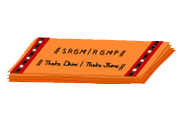Posted By: Administrator
Thanḍai Muzhaṅga
Rāga: Rāgamālikā
Thāḷa: Miśhrachāpu
Composer: Semmanarkoil Shaṇmugam
Language: Thamizh(Tamil)
Meaning – Word by word:
Meaning – Overall: Team Ambalam
Alignment, Diacriticals & consequent spelling changes, Language & grammar editing, if any and necessary, of existing meaning: Team Ambalam
Pallavi
Thanḍai Muzhaṅga Salangai Kulunga Thavazhnthu Varum Murugā- Thamizh
Thālāṭṭu Pāṭṭinil Piḷḷaiyāi Enmun Thāvi Varum Murugā
Thāvi Varum Murugā
Charanam 1
Iru Kai Munnīti Siru Naḍai Naḍanthu Sinthai Kamazh Kumarā
Oru Thénūrum Sollālé Vāi Malarnthingu Siritthu Varum Murugā
Sirithu Varum Murugā
Charanam2
Mānthaḷir Méni Nirathazhagum, Karumai Konḍa Puruvamum
Sensānthiṭṭa Thilakam Sandhana Maṇam Kamazhum Śhankaran Magane Vā
Śhankaran Magane Vā
Charanam 3
Nīla Mayilmél Véluḍan Amarnthu Nī Varum Kātchi Enne-Murugā
Enthan Sinthai Maghizhave Thanjam Alidhe Nesikum Kātchi Endro?
Charanam 4
Thénum Thinaimāvum Thindra Suvaiyāl Thinai Punal Nāḍi Vanthāi-
Ezhil Theḷḷa Thamizh Kūra Peṇṇai Manandhiḍa Theḍiye Oḍi Vandhā
Charanam 5
Mutthōḍu Ratthinam Vaitthu Padhittha Nal Mōhana Punnagaiyum-
Alai Kaṭṭum Kadalsūzh Kandhapuri Vaḷar Kandhavélé Varuga
Meaning:
Pallavi:
Thanḍai Muzhaṅga Salangai Kulunga Thavazhnthu Varum Murugā- Thamizh
Thālāṭṭu Pāṭṭinil Piḷḷaiyāi Enmun Thāvi Varum Murugā
Thāvi Varum Murugā
Thanḍai - anklet
Muzhaṅga -resounds'
Salangai-the bells of the anklet
Kulunga- shakes(referring to the sound produced as the bells in the anklet)
Thavazhnthu Varum-crawl
Thālāṭṭu - lullaby
Pāṭṭinil - song
Piḷḷaiyāi - as a baby
Enmun Thāvi Varum - He jumps up to me
O Muruga! You, as a baby, crawl up to me as I hear one of your anklets resound and the bells in the other tinkle and you jump up to be held as I sing a lullaby.
Charanam 1
Iru Kai Munnīti Siru Naḍai Naḍanthu Sinthai Kamazh Kumarā
Oru Thénūrum Sollālé Vāi Malarnthingu Siritthu Varum Murugā
Sirithu Varum Murugā
Iru- 2 (meaning both)
Kai- hands (this refers to the act of kids who when beginning to walk stretch their hands in front for balance)
Munnīti - stretched to the front
Siru Naḍai Naḍanthu - taking small steps
Sinthai Kamazh - pleases (by the beauty of the above act)
Kumarā - young lad (specially refers to lord Murugā)
Oru- 1
Thénūrum - sweet as coated with honey
Sollālé - word (word as sweet as honey)
Vāi Malarnthingu Siritthu Varum - comes with a (full )smile
O Kumarā, you stretch out both your hands ahead, taking small steps and as words sweet as honey are uttered, come with a full smile.
Charanam2
Mānthaḷir Méni Nirathazhagum, Karumai Konḍa Puruvamum
Sensānthiṭṭa Thilakam Sandhana Maṇam Kamazhum Śhankaran Magane Vā
Śhankaran Magane Vā
Mānthaḷir - tender leaves of the mango tree
Méni Nirathazhagum - complexioned
Karumai Konḍa - black
Puruvamum - eye brows
Sensānthiṭṭa Thilakam - red thilakam (applied on the forehead)
Sandhana Maṇam Kamazhum - fragrance of sandal paste (emanates)
Śhankaran Magane - son of lord shiva
Vā - come to me
Come to me, O son of Śhankara! Your complexion is that of the tender leaves of the mango tree, with dark eyebrows and a red auspicious mark on the forehead of sandal paste; come to me.
Charanam 3
Nīla Mayilmél Véluḍan Amarnthu Nī Varum Kātchi Enne-Murugā
Enthan Sinthai Maghizhave Thanjam Alidhe Nesikum Kātchi Endro?
Nīla Mayilmél - blue peacock
Véluḍan - his spear
Amarnthu - seated (with his spear on the blue peacock)
Nī Varum Kātchi - having a vision of you coming(as above)
Enne?- what words do i have to describe the beauty of it
Enthan Sinthai Maghizhave - to my delight
Thanjam Alidhe - offer me protection
Nesikum Kātchi - (the scene- katchi) of you bestowing your grace upon me
Endro? - when is it?
What to say of the sight of you arriving atop a blue peacock with the spear in your hand, much to my delight? When is the scene of you bestowing your grace upon me and offering me protection, going to occur?
Charanam 4
Thénum Thinaimāvum Thindra Suvaiyāl Thinai Punal Nāḍi Vanthāi-
Ezhil Theḷḷa Thamizh Kūra Peṇṇai Manandhiḍa Theḍiye Oḍi Vandhā
Thénum – honey
Thinaimāvum – a variety of millet; maavum; flour
Thindra – to eat
Suvaiyāl - tasty
Thinai Punal - millet field
Nāḍi – in search of
Vanthāi - came
Ezhil – beautiful
Theḷḷa - slender
Thamizh Kura Peṇṇai – Thamizh gypsy girl,
Manandhiḍa – to marry
Theḍiye – in seach of
Oḍi Vandhā – in hurry – came
Having tasted the mixture of honey and millet flour, you arrive in search of the slender Thamizh gypsy girl, to marry her.
Charanam 5
Mutthōḍu Ratthinam Vaitthu Padhittha Nal Mōhana Punnagaiyum-
Alai Kaṭṭum Kadalsūzh Kandhapuri Vaḷar Kandhavélé Varuga
Mutthōḍu Ratthinam - pearls and gems
Vaitthu Padhittha - embedded
Nal Mōhana Punnagaiyum - attractive smile (like the sheen of pearls and gem studded ornament)
Alai Kaṭṭum - the roaring sound of the waves
Kadalsūzh - surrounded by the sea
Kandhapuri Vaḷar - another name for Thiruchendhūr (one of the arupadai veedu of Murugā- where he wedded valli). This town is on the sea coast
Kandhavélé - another name for Murugā
Varuga - please come
O Murug ā, with your smile having the sheen of a pearls and gem studded ornament, you please come to Kandhapuri(Thiruchendhūr), which is surrounded by the sea and where we can hear the roaring sound of the waves












